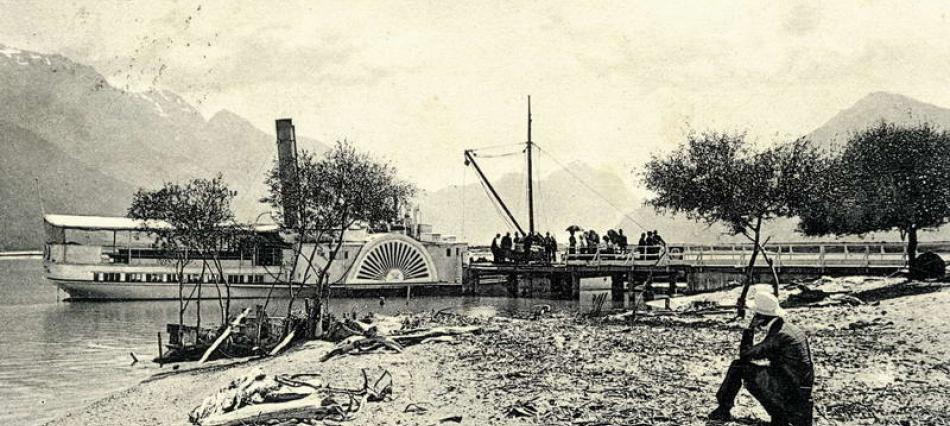
History
The first European settlers arrived at the Head of the Lake probably in late 1861. They were shepherds working for William Rees who had taken a lease on all the land at the Head of Lake Wakatipu, east of the Dart River.
The three shepherds brought a large mob of sheep overland from Queenstown to graze Rees’ lease. Two of these men, Alfred Duncan, after whom Mt Alfred is named, and George Simpson (Simpson’s Creek) built a mud hut near where the Glenorchy Café stands today. This was the beginning of farming which has continued until the present day. While the farming of sheep for wool and meat has always been the main focus of the industry there are also cattle for beef and more recently deer farming. Farming had its highs and lows over the years due to a number of factors including weather, international price fluctuations and the influx of rabbits which devoured every blade of grass available.

The Mt Earnslaw Hotel - 1950s
Some months after Duncan and Simpson arrived in Glenorchy the first gold miners started to trickle in. They ventured along the lake from Queenstown prospecting for gold in the streams on the way until they arrived at the Buckler Burn where they found a significant amount of gold. A ‘town’ was soon established around the miners who are said to have numbered 3000 at their peak. However the easy gold was soon won and the miners moved on to the next ‘Rush’. Gold was also found in the Rees Valley at the Invincible Mine, at Precipice Creek and the Oxburn and a dredge was built in the Dart River.

Haymaking in Glenorchy
Sawmilling took place in a number of areas around the Head of the Lake initially to supply the needs of gold miners at Skippers and Macetown, then, as settlement progressed, timber was supplied for everything from boat building and houses to bridge timbers and fruit boxes. This continued until about 1950 although two major fires in the late 1800’s destroyed most of the remaining forest south of Kinloch.
By the mid 1860’s Tourism was becoming established as the early settlers wrote to their families and friends in Europe telling them of the magnificent scenery in their new home. Steamships were soon plying the Lake and by the end of the century there were 5 hotels at the “Head”. Artists, writers and later photographers came to the area to record the majestic scenes and to climb, hunt and fish. The tourists have continued to travel to the area ever since, although they now travel by road instead of boats.
Scheelite mining began about 1880. It is found mainly on the Richardson Range but also at Paradise, Precipice Creek, Sylvan Lake and Temple Peak. Tungsten is the metallic element of scheelite and this is used in filaments in electric light bulbs and for hardening steel. It was of strategic importance during the First and Second World Wars due to its use in armaments, miners therefore receiving a high price at these times. The scheelite mining industry kept a number of miners employed until after the Korean War when the price dropped and most miners moved away from the area to find more lucrative work.

The scheelite mine portal No. 9 - 1960's
The mid 1950’s saw a push for a road to Queenstown and this was finally opened during the Centennial celebrations in 1962. Glenorchy residents were no longer dependant on the steamers for transport and carriage of goods so after a few years the TSS Earnslaw discontinued its Monday, Wednesday and Friday round trips from Queenstown to the Head of the Lake.
The township of Glenorchy was first surveyed in 1864. Over the years services were provided as required so that by the early 1900’s there was a General Store, a Post and Telegraph Office then later a school as well as two hotels, with a church and a library elsewhere in the district.
Article by Elaine Kirkland

